-
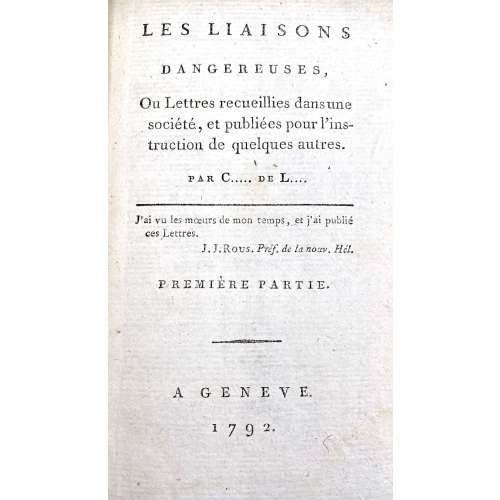 Four parts bound in two 18mo volumes (1-2 & 3-4), half polished brown calf, dot-ruled, flat spine with gilt bands and lettering, marbled boards, some plates with guard sheets, margins sparkled red. Title-page: LES LIAISONS | DANGEREUSES, | Ou Lettres recueillies dans une | société, et publiées pour l’ins- | truction de quelques autres. | par C….. de L… | — | J’ai vu les mœurs de mon temps, et j’ai publié | ces Lettres. | J. J. Rous. Préf. De la nouv. Hél. | PREMIÈRE PARTIE. | — | A GENEVE. | 1792. || Vol. 1: Pagination: ffep, blank, [2] – h.t., [i, ii] – t.p. part one, [iii] iv-xxij, [1] 2-245 [246] + 2 plates (p. 26 & p. 75); [1, 2] – h.t., [3, 4] – t.p. part two, [5] 6-233 [234], fep + 2 plates (p. 59 & p. 222). Collation: part 1: a12, A-M18 N5; part 2: A-M18 N9, plus four plates by various engravers after Le Barbier. Vol. 2: Pagination: ffep, blank, [1, 2] – h.t., [3, 4] – t.p. part three, [5] 6-225 [226] + 2 plates (p. 69 & p. 215); [1, 2] – h.t., [3, 4] – t.p. part four, [5] 6-250, fep + 2 plates (p. 25 & p. 201). Collation: part 3: A-M18 N5; part 4: A-N18 O5, plus four plates by various engravers after Le Barbier. Illustrations: After Le Barbier, engravers: Halbou (1), Simonet (1), N. Thomas (2), Dambrun (2), and Delignon (2). In the first illustration (vol. 1, part one, p. 26) Le Barbier signed “Le Barbier Jnv. 1794”, however, the edition was published (anonymously) in 1792. Cohen-De Ricci mentions an edition of 1794 (Paris: Maradan) and 1801 (Genéve) with the same plates. Lewine mentions a reprint of 1794 without naming the publisher. Catalogue raisonné: Cohen-De Ricci: 234-5, Ray: p. 79; Lewine: 109-10. Contributors: Choderlos de Laclos, Pierre Ambroise François (French, 1741 – 1803) – author. Le Barbier, Jean-Jacques-François (French, 1738 – 1826) – artist Engravers: Dambrun, Jean (French, 1741 – c. 1808) Delignon, Jean Louis (French, 1755 – 1804) Halbou, Louis Michel (1730 – 1809) Thomas, N. (French, c. 1750 – 1812) Simonet, Jean-Baptiste Blaise (French, 1742 – 1813)
Four parts bound in two 18mo volumes (1-2 & 3-4), half polished brown calf, dot-ruled, flat spine with gilt bands and lettering, marbled boards, some plates with guard sheets, margins sparkled red. Title-page: LES LIAISONS | DANGEREUSES, | Ou Lettres recueillies dans une | société, et publiées pour l’ins- | truction de quelques autres. | par C….. de L… | — | J’ai vu les mœurs de mon temps, et j’ai publié | ces Lettres. | J. J. Rous. Préf. De la nouv. Hél. | PREMIÈRE PARTIE. | — | A GENEVE. | 1792. || Vol. 1: Pagination: ffep, blank, [2] – h.t., [i, ii] – t.p. part one, [iii] iv-xxij, [1] 2-245 [246] + 2 plates (p. 26 & p. 75); [1, 2] – h.t., [3, 4] – t.p. part two, [5] 6-233 [234], fep + 2 plates (p. 59 & p. 222). Collation: part 1: a12, A-M18 N5; part 2: A-M18 N9, plus four plates by various engravers after Le Barbier. Vol. 2: Pagination: ffep, blank, [1, 2] – h.t., [3, 4] – t.p. part three, [5] 6-225 [226] + 2 plates (p. 69 & p. 215); [1, 2] – h.t., [3, 4] – t.p. part four, [5] 6-250, fep + 2 plates (p. 25 & p. 201). Collation: part 3: A-M18 N5; part 4: A-N18 O5, plus four plates by various engravers after Le Barbier. Illustrations: After Le Barbier, engravers: Halbou (1), Simonet (1), N. Thomas (2), Dambrun (2), and Delignon (2). In the first illustration (vol. 1, part one, p. 26) Le Barbier signed “Le Barbier Jnv. 1794”, however, the edition was published (anonymously) in 1792. Cohen-De Ricci mentions an edition of 1794 (Paris: Maradan) and 1801 (Genéve) with the same plates. Lewine mentions a reprint of 1794 without naming the publisher. Catalogue raisonné: Cohen-De Ricci: 234-5, Ray: p. 79; Lewine: 109-10. Contributors: Choderlos de Laclos, Pierre Ambroise François (French, 1741 – 1803) – author. Le Barbier, Jean-Jacques-François (French, 1738 – 1826) – artist Engravers: Dambrun, Jean (French, 1741 – c. 1808) Delignon, Jean Louis (French, 1755 – 1804) Halbou, Louis Michel (1730 – 1809) Thomas, N. (French, c. 1750 – 1812) Simonet, Jean-Baptiste Blaise (French, 1742 – 1813) -

A very thin kobushi-gata form iron tsuba decorated in openwork (sukashi), some openings filled with grey metal (silver or pewter) treated in a way to resemble cracked ice, ginkgo leaf to recto and plum blossoms to verso in low-relief (takabori) and gold inlay (zōgan), and unevenly folded over rim (hineri-mimi). The overall theme of the piece is linked to the icy ponds, falling ginkgo leaves and blossoming plums in the late winter.
Size: 84 x 80 mm, thickness (center): 2 mm.Signed: Yamashiro no kuni Fushimi no ju Kaneie [Kaneie of Fushimi in Yamashiro Province] [山城國伏見住金家], with Kaō.
Probably the work of Meijin-Shodai Kaneie (c. 1580 – 1600).
The silver or pewter inlays likely a later work that may be attributed to Goto Ichijo (1791 – 1876) or one of his apprentices in the late 19th century, possibly as a tribute to the great Kaneie masters. Here is an article by Steve Waszak dedicated to Kaneie masters and this tsuba in particular.Kaneie
For many tosogu aficionados, this name reigns supreme among all tsubako across Japanese history. The first Kaneie is celebrated for many things. He is recognized as being the first ever to bring pictorial landscape subjects to a canvas so small as that of a tsuba plate. His skill in being able to render classical Chinese landscape themes while working with a material as unyielding as steel, and to do so with the sensitivity he does, is nothing short of astounding. The quality of his workmanship — especially that of his exquisitely carved motif elements and the extraordinary deftness of his tsuchime (槌目 or 鎚目, hammer-blow) utilizing such thin plates — astonishes even to this day. His sensibilities concerning the shaping of his sword guards and the presentation of the rims were no less innovative than his subject matter. He was among the very first to regularly sign his name as a tsuba smith. And it is likely that he served the great warlord Toyotomi Hideyoshi in the latter years of the 16th century. Despite the great fame and reputation of Kaneie, very little of the lives of the two men who are seen by most scholars as the “true Kaneie” tsubako of the Momoyama and earliest Edo Periods is known to us now. They were both smiths working in steel, with occasional added soft-metal inlay (usually serving to highlight features), and both made sword guards of the same style, using subject matter focused on landscapes, allusions to historical events, or religious themes. The first of these men is often referred to as “O-Shodai,” or Great First Generation, while the second is known as “Meijin-Shodai,” or Famous First Generation. While some see subsequent generations stemming from these first two men, others have the O-Shodai and the Meijin-Shodai as THE two true Kaneie and make a sharp distinction between these two smiths and any others who may share the name.The work of the O-Shodai may appear with two different mei. One of these is written “Joshu Fushimi Ju Kaneie,” while his work may also carry a mei reading “Yamashiro no Kuni Fushimi Ju Kaneie.” It is thought by some scholars that the earlier works present with the “Joshu” mei, while his later works feature the “Yamashiro” mei. However, there are only some five or six tsuba extant with the “Joshu” signature, so we should not necessarily see works with the “Yamashiro” signature as dating only to the latest years of his working life. The answers to the questions of exactly when Kaneie might have begun his life as a tsubako, or how old he was when he moved to sign his works with the “Yamashiro” mei, will probably remain shrouded in uncertainty.The association between Kaneie and Toyotomi Hideyoshi is speculative, to be sure, but the circumstantial evidence is tantalizing. The area of Fushimi is thought to have been an entirely unremarkable land prior to Hideyoshi’s building of a castle there, so it would seem unlikely that the first Kaneie would have been working in such a nondescript place, much less including the place name in his mei, before Hideyoshi’s putting it on the map, so to speak. Why emphasize such pride of place in one’s signature unless the place itself carries a certain weight? The name “Kaneie” translates roughly to “gold family,” which, given Hideyoshi’s notorious love of gold, would seem too much of a coincidence when combined with the explicit mention of Fushimi in the signatures. Combine this with the consideration of what is an equally compelling relationship between the celebrated tsubako Nobuie and Oda Nobunaga (“Nobuie” means roughly “of the family of “Nobu”), whom Hideyoshi served as a top general until Oda’s demise in 1582, and the circumstantial evidence becomes even harder to deny the plausibility of. Oda, ever the innovator, may have been the one responsible for birthing the practice of tsubako regularly signing their works. Having a superb smith like Nobuie affix the name to the tsuba as a regular practice establishes a sort of “brand name,” a brand coming with the seal of approval of Oda Nobunaga. It is more than possible that Nobunaga may have then used these valuable sword guards as rewards given to vassals and other important relations to honour them for their services to him, a practice that would have allowed Nobunaga to avoid having to use gold, guns, swords, horses, or land to do so. The awarding of a magnificent Nobuie tsuba to a deserving warrior, an appreciated ally, or a family member would bring honour to the recipient, of course, but would also honour the maker of the sword guard, and even the giver of the object. Such a way of thinking would be absolutely typical of him, and given that both Oda Nobunaga and Nobuie were men of Kiyosu in Owari in the early Momoyama Period, it does not strain credulity to imagine that the above dynamic could have occurred in just this way. If indeed it did, Toyotomi Hideyoshi is unlikely to have let this pass unnoticed. He may even have been so honoured himself! When he rose to power very shortly after Oda’s death, then, and when he reinforced and consolidated that power in the late 1580s and early 1590s, which included the building of the castle at Fushimi, perhaps he sought to emulate the Oda vision and practice of establishing a “royal tsubako.” If so, Kaneie would have been that smith.As noted, this scenario is speculative, and not a little romantic. This does not mean, however, that it is in fact not likely, for there would be a number of coincidences involved for it to be entirely false.Tsuba scholars will say that Kaneie’s skills in the making of his sword guards indicate an armour-making background. This is an interesting viewpoint, but one can’t help but wonder how many armourers were possessed of such fluent literacy in lyrical Chinese historical tales that they could then represent them as motifs on steel plates. Kaneie subjects often are in the form of Chinese landscapes and allusions, as noted, one of which — The Eight Views of the Xiao and the Xiang — was very well known as a famous subject of Chinese painting and poetry from the Song Dynasty. There exist Kaneie tsuba which depicts at least some of these “views,” and it seems unlikely that if one or more of them were to be created, not all of them would be, in a sort of “series.” The cultural and literary fluency Kaneie would seem to have had, then, may suggest a Buddhist background, and indeed, some of the subjects seen are explicitly Buddhist in nature. Perhaps his background then, somehow offering a dovetailing of metalwork and Buddhist teachings; in any event, we are all the richer for at least some of the works of Kaneie to have survived to reach us today.One of the hallmarks of Kaneie tsuba (real ones) is the extreme thinness of the plate, combined with utterly superb tsuchime expression of that plate. To be able to hammer the plate to achieve such strength of expression while the plate is so thin is seen by the Japanese as practically miraculous. A notable and important kantei point between the early masterpieces by the two “Shodai” Kaneie and the tsuba made by followers is this thinness of the plate. Another kantei point: because the plate is so thin when raised areas representing motif elements are present, they are inlaid into the plate, because trying to carve them from such a thin plate would be practically impossible: the likelihood of piercing the plate would be high, and the plate in that area, even if not pierced, would be significantly weakened by trying to manage the raising of a motif element from the plate. In real Kaneie works, then, one would expect any raised motif elements to be inlaid.Other highlights: the “Shodai” Kaneie are famous for the kobushi-gata (拳形) or “fist-shaped” design in their work, but despite this, there actually aren’t that many extant sword guards boasting this shape. Another feature for which the Kaneie are justly famous is their folding over of the lip of the rim onto the plate in a very tasteful manner, just here and there, rather than uniformly across the tsuba. However, again, this feature is actually not commonly seen, either. The combination, then, of a kobushi-gata shape with the rim folded over in just a few areas is that much rarer.Which brings us to the featured piece.Here is a Kaneie tsuba, a “Meijin-Shodai” Kaneie, which presents with a very thin plate, being between 1.5 and 2mm in thickness. The motif elements are inlaid, as we should expect. The sugata (姿, shape) is Kobushi-gata with the rim folded over in only a few places, representing a relatively infrequently encountered form, as stated. The tsuba here is fortunate not to have any added hitsu-ana, unlike many or most other Kaneie do. The sukashi elements are fascinating to consider, being difficult to determine the meaning of; however, the raised elements clearly point to a seasonal motif, with cherry and plum blossoms on the omote for Spring, and ginkgo on the ura for Fall. The inlaid metal in two of the openings — silver, shibuichi, or pewter, perhaps — is very likely a later addition, probably 19th-century, and more specifically, late-19th-century. The finishing on these inlaid portions has all the hallmarks of Goto Ichijo workmanship. Namely, the treatment of the surface of the inlay to resemble fallen snow (in the Japanese sense of things) is expressed in a very Ichijo sense of things, and, given the great importance of Kaneie tsuba, and the seasonal expression the motif of the guard has, it is plausible that the inlay is Ichijo work or that of one of his top students. In any event, this inlay complements the rest of the tsuba beautifully. The inlay also resembles the art of kintsugi (金継ぎ, golden joinery) or the Japanese practice of ceramic repair using lacquer when a piece is particularly special or important. In this way, a nod is given to Tea Culture, too, creating a wonderful blending of associations and allusions, typical of the highest Japanese aesthetic sense.At 8.4cm, the tsuba is of an excellent size and is in great condition (no rust, no deep rust pitting, no fire damage). There is, intriguingly, one small sign of battle damage at 6:00 on the guard: it would seem a sword blow cut into the tsuba at the rim, and penetrated slightly into the plate. The superb repair represented by a little stitch or two right at the rim and along a few millimetres of the plate is visible on very close inspection. The repair is old, probably nearly contemporary with when the tsuba was made. Given the high status of Kaneie in their lifetime (as tsubako for Hideyoshi, one might imagine their importance), and given the obvious high quality of this piece, it is not surprising that the finest repair efforts were put into its care.The name Kaneie justly enjoys its fame and accolades as pre-eminent among the tens of thousands of tsubako in Japanese history. We are fortunate indeed to have had a small number of the works of the early masters survive to this day. The first of their kind, and as most scholars and aficionados would wholeheartedly agree, the best of their kind, Kaneie sword guards remain among the very finest examples of the Japanese metal-working traditions. -
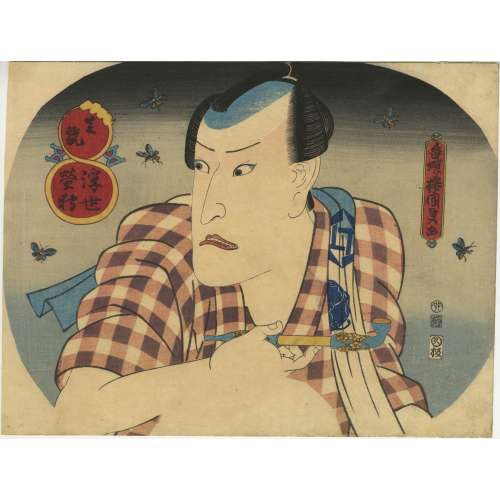 Uncut fan print (uchiwa-e) with the design of kabuki actor Nakamura Utaemon IV who held the name of Nakamura Shikan II from the 11th lunar month of 1825 to the 12th lunar month of 1835, dressed in a checkered kimono, holding a pipe and surrounded by flying fireflies. Character: Nakamura Utaemon IV [中村歌右衛門] (Japanese, 1796 – 1852); other names: Nakamura Shikan II, Nakamura Tsurusuke I, Nakamura Tōtarō. Series title: Catching fireflies in the floating world [浮世蛍狩] (Ukiyo hotarugari). Artist: Utagawa Kunisada [歌川 国貞], a.k.a. Toyokuni III (Japanese, 1786 – 1865). Signed: Kōchōrō Kunisada ga [香蝶楼国貞画] in a red cartouche. Publisher: Ibaya Kyubei [伊場屋 久兵衛] (Japanese, fl. 1804 – 1851); seal: modified Marks 19-009 | 126d. Censor's seal: Kiwame Date seal: Tenpō 2 (1831). Ref: Kunisada.de, N58. A look-alike yearlier Kunisada's design can be found at kunisada.de, ref. # N120-Z0172-410:
Uncut fan print (uchiwa-e) with the design of kabuki actor Nakamura Utaemon IV who held the name of Nakamura Shikan II from the 11th lunar month of 1825 to the 12th lunar month of 1835, dressed in a checkered kimono, holding a pipe and surrounded by flying fireflies. Character: Nakamura Utaemon IV [中村歌右衛門] (Japanese, 1796 – 1852); other names: Nakamura Shikan II, Nakamura Tsurusuke I, Nakamura Tōtarō. Series title: Catching fireflies in the floating world [浮世蛍狩] (Ukiyo hotarugari). Artist: Utagawa Kunisada [歌川 国貞], a.k.a. Toyokuni III (Japanese, 1786 – 1865). Signed: Kōchōrō Kunisada ga [香蝶楼国貞画] in a red cartouche. Publisher: Ibaya Kyubei [伊場屋 久兵衛] (Japanese, fl. 1804 – 1851); seal: modified Marks 19-009 | 126d. Censor's seal: Kiwame Date seal: Tenpō 2 (1831). Ref: Kunisada.de, N58. A look-alike yearlier Kunisada's design can be found at kunisada.de, ref. # N120-Z0172-410:
Actor Onoe Baikō, artist Kunisada, publisher Ibaya Kyūbei, c. 1820.
-
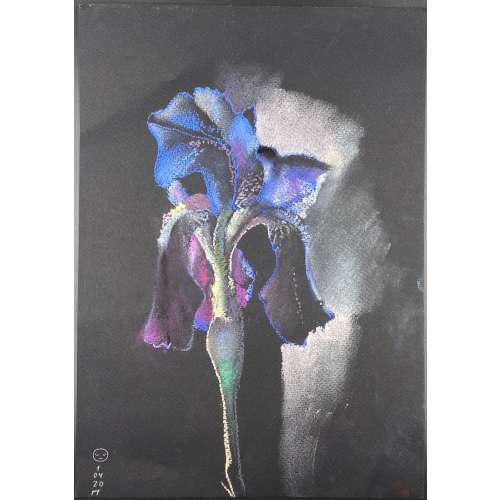 Polina de Mauny [Vladimirova] (Russian, French, b. 1981). Dry pastel on black paper. Size: 30 x 21 cm.
Polina de Mauny [Vladimirova] (Russian, French, b. 1981). Dry pastel on black paper. Size: 30 x 21 cm. -
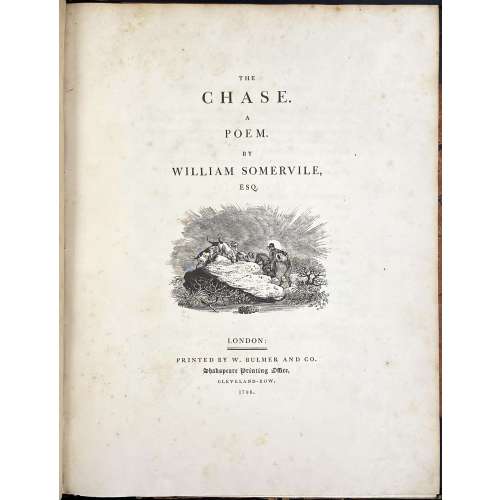 Royal 4to, 29.8 x 23.5 cm, contemporary half brown morocco, marbled boards gilt ruled, spine with gilt-ruled raised bands, gilt title lettering; "William Gore" armorial bookplate to front pastedown. Title page: THE | CHASE. | A | POEM. | BY | WILLIAM SOMERVILLE, | ESQ. | [VIGNETTE] | LONDON : | PRINTED BY W. BULMER AND CO. | Shakespeare Printing Office, | CLEVELAND-ROW. | 1796. Collation: without signatures. — Pagination: [i-v] vi-xv [xvi], [i] ii-vii [viii], [1-5] 6-126; illustrations: engraved title, 4 running titles, 4 headpieces, 4 tailpieces – 13 altogether, all drafted by John Bewick, 12 executed by Thomas Bewick and the last one by Charlton Nesbit. Catalogue Raisonné: Thomas Hugo. The Bewick Collector, vol. 1 (1866): p. 38, № 94: "The first edition... was printed in royal 4to". John Bewick made all the drawing on the blocks but was not able to execute the engravings himself "because of ill-health. They were engraved by Thomas Bewick, with the exception of the tail-piece at the end of the volume, which was engraved by Nesbit". Thomas Bewick (c. 11 August 1753 – 8 November 1828); John Bewick (1760 – 1795), the younger brother of Thomas, died at the age of 35. Christie's, who sold a similar copy on 29 Oct 2012, provides for the size 2°.
Royal 4to, 29.8 x 23.5 cm, contemporary half brown morocco, marbled boards gilt ruled, spine with gilt-ruled raised bands, gilt title lettering; "William Gore" armorial bookplate to front pastedown. Title page: THE | CHASE. | A | POEM. | BY | WILLIAM SOMERVILLE, | ESQ. | [VIGNETTE] | LONDON : | PRINTED BY W. BULMER AND CO. | Shakespeare Printing Office, | CLEVELAND-ROW. | 1796. Collation: without signatures. — Pagination: [i-v] vi-xv [xvi], [i] ii-vii [viii], [1-5] 6-126; illustrations: engraved title, 4 running titles, 4 headpieces, 4 tailpieces – 13 altogether, all drafted by John Bewick, 12 executed by Thomas Bewick and the last one by Charlton Nesbit. Catalogue Raisonné: Thomas Hugo. The Bewick Collector, vol. 1 (1866): p. 38, № 94: "The first edition... was printed in royal 4to". John Bewick made all the drawing on the blocks but was not able to execute the engravings himself "because of ill-health. They were engraved by Thomas Bewick, with the exception of the tail-piece at the end of the volume, which was engraved by Nesbit". Thomas Bewick (c. 11 August 1753 – 8 November 1828); John Bewick (1760 – 1795), the younger brother of Thomas, died at the age of 35. Christie's, who sold a similar copy on 29 Oct 2012, provides for the size 2°. -
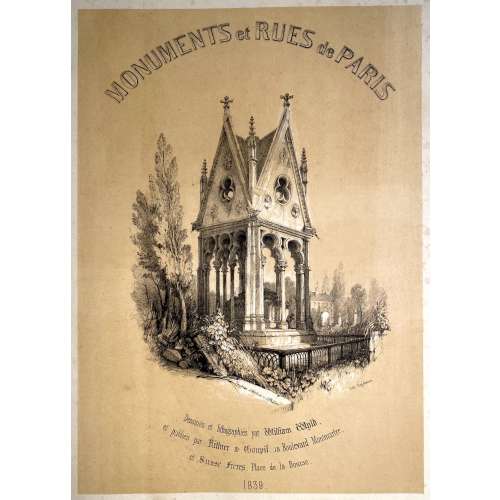 Pictorial album 55.5 x 41.0 cm, publisher’s quarter sheepskin over cloth, upper cover and flat spine lettered in gilt. Title: MONUMENTS et RUES de PARIS | Dessinés et lithographiés par William Wyld, | et publiés par Rittner & Goupil, 15 Boulevard Montmartre, | et Susse Frères, Place de la Bourse. | 1839. Collation: Title plate + 20 plates numbered from 1 to 20, printed by Godefroy Engelmann (French, 1788 – 1839) in tone lithography after drawings by William Wyld (British, 1806 – 1889). Published in Paris by Rittner & Goupil and Susse Frères in 1839. Plates: 54.8 x 39.8 cm. Contents:
Pictorial album 55.5 x 41.0 cm, publisher’s quarter sheepskin over cloth, upper cover and flat spine lettered in gilt. Title: MONUMENTS et RUES de PARIS | Dessinés et lithographiés par William Wyld, | et publiés par Rittner & Goupil, 15 Boulevard Montmartre, | et Susse Frères, Place de la Bourse. | 1839. Collation: Title plate + 20 plates numbered from 1 to 20, printed by Godefroy Engelmann (French, 1788 – 1839) in tone lithography after drawings by William Wyld (British, 1806 – 1889). Published in Paris by Rittner & Goupil and Susse Frères in 1839. Plates: 54.8 x 39.8 cm. Contents:Title page: Tombeau d'Heloïse et d'Abélard
- Le Pont Neuf
- L'église de la Madeleine
- La Porte St. Martin
- Palais des Tuileries
- Pont des Saints-Pères
- Hôtel de Ville
- Marché des Innocents
- Palais Royal
- Boulevard des Italiens
- Rue de la Paix
- Bourse et Tribunal de Commerce
- Porte St. Denis
- Pont Royal
- Place de la Concorde
- Paris from Père Lachaise
- Notre-Dame
- Jardin des Tuileries with Arc de Triomphe in the Distance
- Panthéon
- Chambre des députés
- Arc de Triomphe de l'Étoile
-
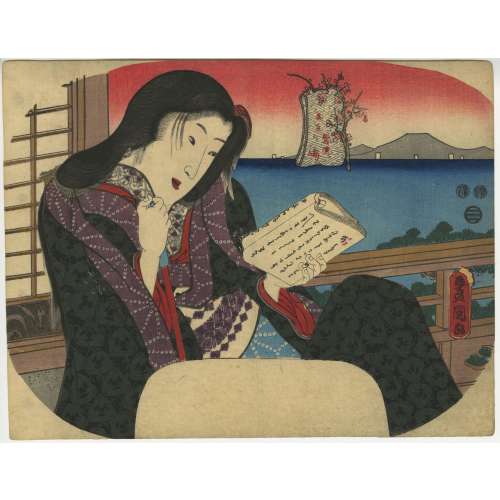 Artist: Utagawa Kunisada [歌川 国貞] a.k.a. Utagawa Toyokuni III [三代歌川豊国] (Japanese, 1786 – 1865). Signed: Toyokuni ga [豊国 画] in a red toshidama cartouche. Publisher: Ibaya Senzaburō [伊場屋仙三郎] (Japanese, c. 1815 – 1869). Double nanushi censor seals: Hama & Magome, Kaei 2-5 (1849 – 1852). An uncut fan print (uchiwa-e, 220 x 292 mm) depicts a beautiful woman sitting on a balcony overlooking a bay and reading a book. Above the book, there is an obi with a pattern of stripes or modified key fret motif, with lettering that reads: 菅原島 [Sugawara-jima] and 美立 [mitate]. The lettering and the blossoming plum branch next to the obi provide an allusion to Sugawara no Michizane [菅原 道真/菅原 道眞] (Japanese, 845 – 903) - a prominent scholar and poet of Heian period exiled from Kyoto to the island of Kyushu as a result of another courtier's slander. A legend says that his beloved plum tree was so fond of its master that it flew to Kyushu with Sugawara. The Davis Museum at Wellesley College describes the print as belonging to the series A Parody of Sugawara Stripe Patterns (Mitate Sugawara-jima). To make the fact of an allusion transparent, Kunisada had changed the usual way of writing "Sugawara stripes" from 菅原縞 to 菅原島 and "mitate" from 見立 to 美立. An unusual spelling was also used to provide additional information to the reader in other cultures. E.g. during the Prohibition Era, the West Coast United States speakeasy bars and bordellos misspelt the items on a menu ("scollops") or in a neon sign ("Martuni's") to tell: here we have more pleasures for you than you may have expected. After Tenpō reforms, the printing of bijin-ga (美人画, "picture of beautiful woman") images was restricted. Our print disguises a typical bijin-ga as an advertisement of an obi (帯, a kimono sash) fabric pattern. "The market of portraits was satisfied and the authorities fooled" [Rebecca Salter. Japanese popular prints. — Honolulu: University of Hawaii Press, 2006].
Artist: Utagawa Kunisada [歌川 国貞] a.k.a. Utagawa Toyokuni III [三代歌川豊国] (Japanese, 1786 – 1865). Signed: Toyokuni ga [豊国 画] in a red toshidama cartouche. Publisher: Ibaya Senzaburō [伊場屋仙三郎] (Japanese, c. 1815 – 1869). Double nanushi censor seals: Hama & Magome, Kaei 2-5 (1849 – 1852). An uncut fan print (uchiwa-e, 220 x 292 mm) depicts a beautiful woman sitting on a balcony overlooking a bay and reading a book. Above the book, there is an obi with a pattern of stripes or modified key fret motif, with lettering that reads: 菅原島 [Sugawara-jima] and 美立 [mitate]. The lettering and the blossoming plum branch next to the obi provide an allusion to Sugawara no Michizane [菅原 道真/菅原 道眞] (Japanese, 845 – 903) - a prominent scholar and poet of Heian period exiled from Kyoto to the island of Kyushu as a result of another courtier's slander. A legend says that his beloved plum tree was so fond of its master that it flew to Kyushu with Sugawara. The Davis Museum at Wellesley College describes the print as belonging to the series A Parody of Sugawara Stripe Patterns (Mitate Sugawara-jima). To make the fact of an allusion transparent, Kunisada had changed the usual way of writing "Sugawara stripes" from 菅原縞 to 菅原島 and "mitate" from 見立 to 美立. An unusual spelling was also used to provide additional information to the reader in other cultures. E.g. during the Prohibition Era, the West Coast United States speakeasy bars and bordellos misspelt the items on a menu ("scollops") or in a neon sign ("Martuni's") to tell: here we have more pleasures for you than you may have expected. After Tenpō reforms, the printing of bijin-ga (美人画, "picture of beautiful woman") images was restricted. Our print disguises a typical bijin-ga as an advertisement of an obi (帯, a kimono sash) fabric pattern. "The market of portraits was satisfied and the authorities fooled" [Rebecca Salter. Japanese popular prints. — Honolulu: University of Hawaii Press, 2006]. -
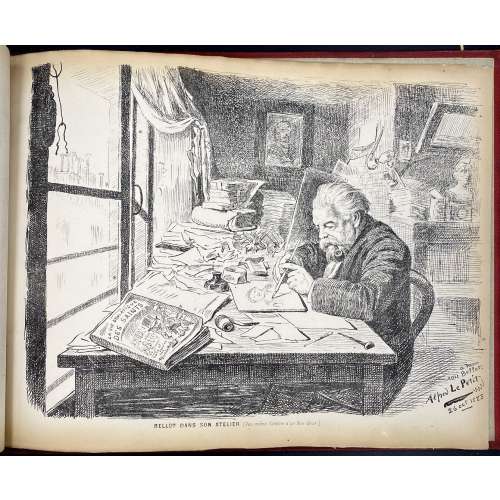 An album of the "Le Bon-Bock" dinners for the year 1884. Author, designer and publisher – Emile Bellot (French, 1831 – 1886), a Parisian artist and engraver. "Le Bon-Bock" was a monthly dinner of artists and men of letters, who gathered in Paris for good food, good company, and artistic performances, from 1875 to at least 1925. The story behind these gatherings as told by Emile Bellot, the founder, is this:
An album of the "Le Bon-Bock" dinners for the year 1884. Author, designer and publisher – Emile Bellot (French, 1831 – 1886), a Parisian artist and engraver. "Le Bon-Bock" was a monthly dinner of artists and men of letters, who gathered in Paris for good food, good company, and artistic performances, from 1875 to at least 1925. The story behind these gatherings as told by Emile Bellot, the founder, is this:In February 1875, Pierre Cottin1 came to me and said: 'I discovered a poet and tragedian of immense talent and who interprets the poems of the Great Victor Hugo in an astonishing way. Monsieur Gambini. I promised him that I would make it heard by an audience of artists and men of letters. I am counting on you who have many connections to keep my promise to him'. I gathered about 25 of my friends and acquaintances in a picnic dinner which took place at a restaurant 'Krauteimer' on the rue Rochechouart in Montmartre. They heard from Mr Gambini first, then my friends Étienne Carjat2, J. Gros3, Adrien Dézamy4, etc. performed. These gentlemen completed the evening so brilliantly that it was unanimously decided that we would start a similar dinner every month. Poets, musicians, men of letters, singers would be invited to this dinner. I was in charge of the organization of this little party and as it was the dream of my life to bring together old comrades, I was careful not to refuse and I pursued this good idea. Cottin and René Tener5 were kind enough to help me in this joyous task and especially my old friend Carjat. The following March began our 1st monthly dinner.
The name "Le Bon-Bock" means "The Good Bock", whilst Bock is a kind of beer, a dark, malty, lightly hopped ale. The dinner was named "Le Bon-Bock" in honour of the Éduard Manet painting (1873), a famous portrait of Emile Bellot, called "Le Bon-Bock".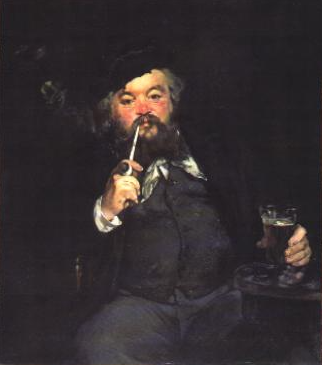 The invitations to the dinner were also produced by the artists and looked like this one by Alexandre Ferdinandus (October 3, 1883).
The invitations to the dinner were also produced by the artists and looked like this one by Alexandre Ferdinandus (October 3, 1883).
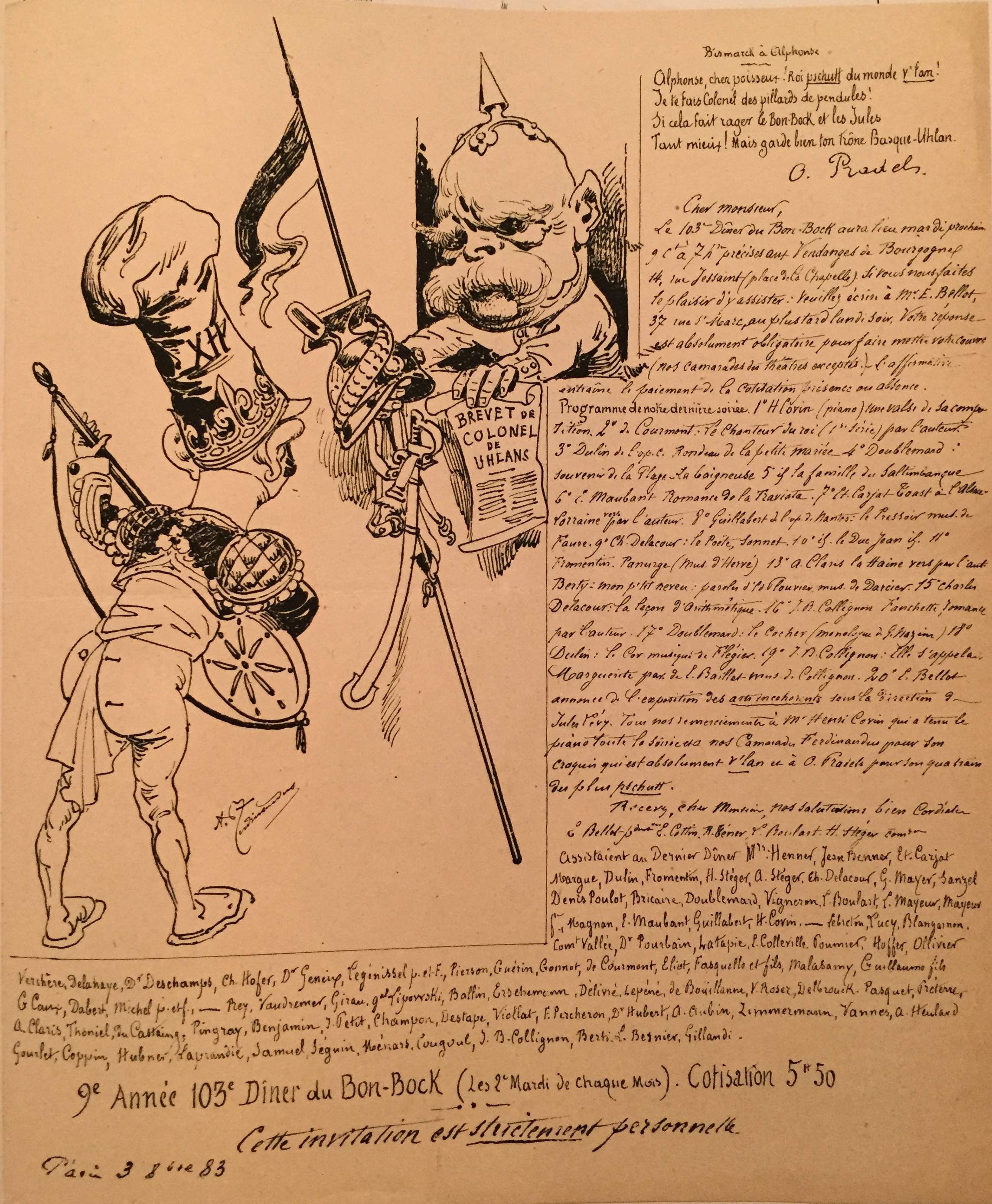 Besides this sketch of the Parisian social and artistic life at the end of the 19th century, the provenance of the album in our collection generates additional interest. The ink stamp to the front flyleaf reads: "Docteur Henry Uzan, 29 Avenue Perrichont, Paris XVI".
Doctor Henry Uzan was Jewish. He was arrested by the Pétain police on October 1, 1941, and interned in Drancy. With the few means at his disposal, he undertook to treat the sick whom he then saw leaving, week after week, towards their terrible destiny in the extermination camps. In October 1943 doctor Uzan was deported to the island of Alderney. After the Normandy Landing of June 6, 1944, Nazis evacuated the island detainees and transfer them to the Neuengamme camp, via northern France and Belgium. During the transfer, doctor Uzan managed to escape from the train on the night of September 3 to 4 around Dixmude in Flanders. He was taken in by the Belgian Resistance, which he joined before being repatriated to France.
In France, he continued working as a physician and was one of the founders of Association des internés et déportés politiques (AIDP). In 1945, together with his friends, the doctor designed the symbol for the Fédération nationale des déportés et internés résistants et patriotes:
Besides this sketch of the Parisian social and artistic life at the end of the 19th century, the provenance of the album in our collection generates additional interest. The ink stamp to the front flyleaf reads: "Docteur Henry Uzan, 29 Avenue Perrichont, Paris XVI".
Doctor Henry Uzan was Jewish. He was arrested by the Pétain police on October 1, 1941, and interned in Drancy. With the few means at his disposal, he undertook to treat the sick whom he then saw leaving, week after week, towards their terrible destiny in the extermination camps. In October 1943 doctor Uzan was deported to the island of Alderney. After the Normandy Landing of June 6, 1944, Nazis evacuated the island detainees and transfer them to the Neuengamme camp, via northern France and Belgium. During the transfer, doctor Uzan managed to escape from the train on the night of September 3 to 4 around Dixmude in Flanders. He was taken in by the Belgian Resistance, which he joined before being repatriated to France.
In France, he continued working as a physician and was one of the founders of Association des internés et déportés politiques (AIDP). In 1945, together with his friends, the doctor designed the symbol for the Fédération nationale des déportés et internés résistants et patriotes:
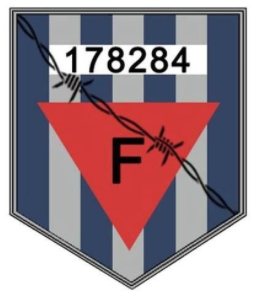 The story behind the number on the emblem (178284) is fascinating but it is out of the scope of this material.
The story behind the number on the emblem (178284) is fascinating but it is out of the scope of this material.
1. Pierre Cottin (French, 1823 – c. 1887) – Engraver, mezzotinter, genre and landscape painter; born in Chappelle-Saint-Denis (near Paris), a pupil of Jazet. Exhibited at the Salon from 1845, also in London from 1876 to 1879.↩ 2. Étienne Carjat (French, 1828 – 1906) – Journalist, caricaturist and photographer. ↩ 3. Jean Baptiste Louis Gros (French, 1793 – 1870) – Painter. ↩ 4. Adrien Dézamy (French, 1844 – 1891) – Writer, poet, general secretary of the Théâtre des Bouffes in Paris. ↩ 5. Rene Tener (French, 1846 – 1925) – Painter. ↩ Sources:Auguste Lepage. Les dîners artistiques et littéraires de Paris / Bibliothèque des Deux mondes (2e éd.) – Paris: Frinzine, Klein et Cie., 1884. [Accession № LIB-2606.2021 in this collection]
-
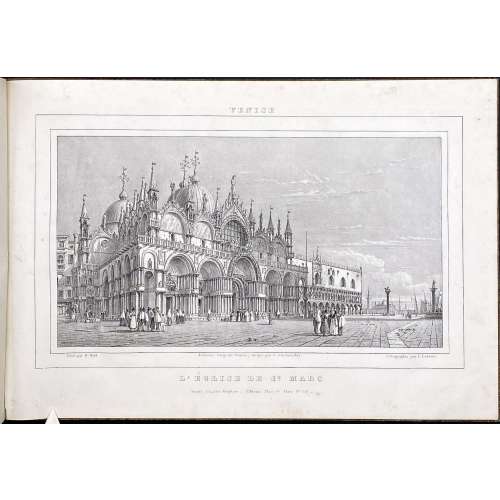 Owner's convolute binding of the period in quarter tan cloth, yellow marbled boards, no title page, no pagination. Contents: (1) Venetian Album –12 lithographs by Émile-Aubert Lessore (French, 1805 – 1876) after William Wyld (British, 1806 – 1889). — Venice: Charles Hopfner, [1834]. Printed at Premiata Litografia Veneta under the direction of Ferdinand Wolfgang Flachenecker (German, 1782 – 1847). Inscription: Premiata Litografia Veneta, dirigée par C. Flachenecker.
Owner's convolute binding of the period in quarter tan cloth, yellow marbled boards, no title page, no pagination. Contents: (1) Venetian Album –12 lithographs by Émile-Aubert Lessore (French, 1805 – 1876) after William Wyld (British, 1806 – 1889). — Venice: Charles Hopfner, [1834]. Printed at Premiata Litografia Veneta under the direction of Ferdinand Wolfgang Flachenecker (German, 1782 – 1847). Inscription: Premiata Litografia Veneta, dirigée par C. Flachenecker.- L'Église de St. Marc
- La place St. Marc
- Le palais Ducal
- Le Môle
- L'Arsenal
- La Riva dei Schiavoni
- Le Grand Canal, (1re vue)
- Le Grand Canal (2me vue)
- Le Grand Canal (3me vue)
- Le Grand Canal (4me vue)
- Le Grand Canal (5me vue)
- Le Grand Canal (6me vue)
- Title: Spiegazione / delli quattro prospetti dei bassi rilievi in marmo che circondano le mura della S. Casa di Loreto / qui annessi in puntata, oltre l'altro prospetto del palazzo pontificio / facciata del tempio, campanile, e cuppola etc.
- Prospetto della Basilica, e Piazza Lauretana, ed annesso Palazzo Apostolico / V. Jaffei incise.
- Settentrione. Prospetto laterale de Bassirilievi in Marmo, che circondano le Mura di S. Casa di Loreto. Jaffei incise Loreto.
- Oriente. Prospetto de Bassirilievi in Marmo, che circ=ondano le Mura di S. Casa. Jaffei incise Loreto l'Anno 1828.
- Mezzo Giorno. Prospetto laterale de Bassirilievi in Marmo, che circondano le Mura di S. Casa di Loreto. Jaffei dis. ed inc. in Loreto.
- Occidente. Prospetto de Bassirilievi in Marmo, che circ=ondano le Mura di S. Casa. Jaffei dis. ed inc. in Loreto l'Anno 1828.
-
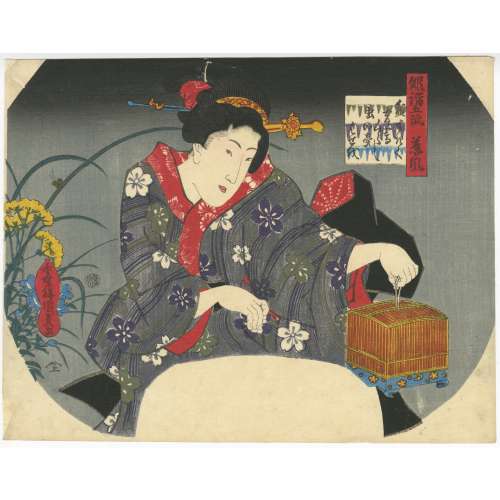 Artist: Utagawa Kunisada [歌川 国貞] a.k.a. Utagawa Toyokuni III [三代 歌川 豊国] (Japanese, 1786 – 1865). Signed: Kōchōrō Kunisada ga [香蝶楼国貞画] in a double-gourd cartouche. Iseya Sōemon [伊勢屋惣右衛門] (Japanese, 1776 – 1862); seal: Ue [上] (Marks 02-041 | 156a). Inscription in the red stripe: Five types of haiku in shōfū style [俳諧五流蕉風] (Haikai gōryū shōfū). Censor's seal: Watari [渡] (Watanabe Shōemon), VI/1842–V ic/1846. Media: Fan print [団扇絵] (Uchiwa-e); size: 225 x 292 mm. An uncut fan print depicts a young woman with an insect (firefly) cage in her left hand. Her striped kimono is adorned with the design of white, grey and blue cherry blossoms. Two of the Seven Grasses of Autumn [秋の七草] (aki no nanakusa), namely Platycodon grandiflorus (kikyō) [桔梗] a.k.a. Chinese bellflower (or balloon flower) and Patrinia scabiosifolia (ominaeshi) [女郎花] a. k.a. Eastern (or Golden) Valerian, are seen on her right-hand side.
Artist: Utagawa Kunisada [歌川 国貞] a.k.a. Utagawa Toyokuni III [三代 歌川 豊国] (Japanese, 1786 – 1865). Signed: Kōchōrō Kunisada ga [香蝶楼国貞画] in a double-gourd cartouche. Iseya Sōemon [伊勢屋惣右衛門] (Japanese, 1776 – 1862); seal: Ue [上] (Marks 02-041 | 156a). Inscription in the red stripe: Five types of haiku in shōfū style [俳諧五流蕉風] (Haikai gōryū shōfū). Censor's seal: Watari [渡] (Watanabe Shōemon), VI/1842–V ic/1846. Media: Fan print [団扇絵] (Uchiwa-e); size: 225 x 292 mm. An uncut fan print depicts a young woman with an insect (firefly) cage in her left hand. Her striped kimono is adorned with the design of white, grey and blue cherry blossoms. Two of the Seven Grasses of Autumn [秋の七草] (aki no nanakusa), namely Platycodon grandiflorus (kikyō) [桔梗] a.k.a. Chinese bellflower (or balloon flower) and Patrinia scabiosifolia (ominaeshi) [女郎花] a. k.a. Eastern (or Golden) Valerian, are seen on her right-hand side. -
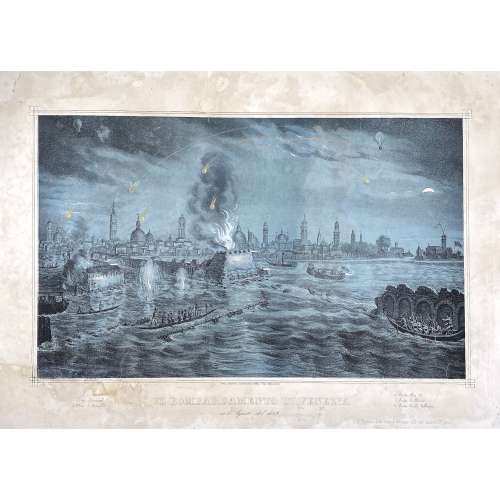 Quaritch's description: Single sheet (435 x 625 mm); coloured lithograph by Kirchmayr after a drawing by M. Fontana; hand-painted details; signed to lower left ‘M. Fon[tana]’ and to lower right ‘M. Fontana Edit. Prop. S. Giacomo dall’Orio in Isola N°.1481’; lower margin with the title ‘Il bombardamento di Venezia nell’Agosto 1849’ and key; restored tears in many places, especially along upper and lower blank margins, some affecting print; losses to lower left corner, affecting a small portion of the print, ruled border, and key, restored and re-drawn where needed; loss to the upper left corner of blank margin; two small areas of restoration to the centre of upper blank margin; the whole sheet backed; nevertheless a remarkable survival. Exceedingly rare and striking lithograph of Venice as seen from Fusina, depicting the first ever aerial bombardment in history. The bombardment took place in 1849, under the orders of Field Marshal Josef Radetzky (1766–1858), to quell the revolts that had started the previous year during the First Italian War of Independence. This curious and little-known action was the brainchild of Colonel Benno Uchatius, a brilliant young officer in the Austro-Hungarian Artillery. After long months of unsuccessful siege, Uchatius decided to deploy an unusual weapon: a hot air balloon able to bomb the city from above. Having calculated the wind speed and direction and evaluated the requisite dimensions of the hot-air balloon, Uchatius set up a workshop near Mestre, where a group of engineers and craftsmen began to manufacture a balloon equipped with a large wicker basket which could transport two crewmen and approximately one hundred kilograms of small long-fuse devices (metal spheres filled with gunpowder, pitch, oil and five hundred rifle buckshot). The initial trials, however, proved to be a disaster, because the balloon would drift off course, making it impossible to accurately deploy the bombs. Uchatius then hit upon the idea of using several smaller unmanned balloons roped together. These were to be launched over the city and, using the position of the first ‘pilot’ balloon, which was unarmed, the Austrians could calculate the correct fuse settings for the bombs. The ‘bomber’ balloons had a cloth envelope of one hundred cubic metres and a reduced load of about twenty kilograms of ordnance. According to Uchatius’ calculations, the line of balloons, launched from Mestre, would reach the lagoon city in thirty-five to forty minutes, carried by the north-west wind. In July 1849, a first launch was attempted, but when a breeze began to blow from the sea some of the balloons broke the connecting ropes and floated away, while others settled in the water in front of the northern part of the city, where a curious crowd of Venetians observed the failure of the enterprise and commented colourfully on the ‘buffoonery of Radetzky’. Uchatius’ second attempt, which is depicted in this lithograph, was also largely unsuccessful: only a few of the unmanned bomber balloons reached their target, and some even drifted back over the Austrian lines. Uchatius, having accomplished the first ever aerial bombardment, and having designed the first ever military ‘drones’, was forced to abandon the project permanently. Another fascinating aspect of this work is the vantage point used to depict the city of Venice, seen here from Fusina, a very rare viewpoint that makes this piece even more remarkable. We were unable to locate any copies in any institution or bibliography. G. Kirchmayr (fl. mid-19th century) is mentioned at British Museum database as "Lithographer active in Venice; related to Venetian painter Cherubino Kirchmayr (b. 1848)?" However, I was not able to find that name on the print. Not much is known of M. Fontana either.
Quaritch's description: Single sheet (435 x 625 mm); coloured lithograph by Kirchmayr after a drawing by M. Fontana; hand-painted details; signed to lower left ‘M. Fon[tana]’ and to lower right ‘M. Fontana Edit. Prop. S. Giacomo dall’Orio in Isola N°.1481’; lower margin with the title ‘Il bombardamento di Venezia nell’Agosto 1849’ and key; restored tears in many places, especially along upper and lower blank margins, some affecting print; losses to lower left corner, affecting a small portion of the print, ruled border, and key, restored and re-drawn where needed; loss to the upper left corner of blank margin; two small areas of restoration to the centre of upper blank margin; the whole sheet backed; nevertheless a remarkable survival. Exceedingly rare and striking lithograph of Venice as seen from Fusina, depicting the first ever aerial bombardment in history. The bombardment took place in 1849, under the orders of Field Marshal Josef Radetzky (1766–1858), to quell the revolts that had started the previous year during the First Italian War of Independence. This curious and little-known action was the brainchild of Colonel Benno Uchatius, a brilliant young officer in the Austro-Hungarian Artillery. After long months of unsuccessful siege, Uchatius decided to deploy an unusual weapon: a hot air balloon able to bomb the city from above. Having calculated the wind speed and direction and evaluated the requisite dimensions of the hot-air balloon, Uchatius set up a workshop near Mestre, where a group of engineers and craftsmen began to manufacture a balloon equipped with a large wicker basket which could transport two crewmen and approximately one hundred kilograms of small long-fuse devices (metal spheres filled with gunpowder, pitch, oil and five hundred rifle buckshot). The initial trials, however, proved to be a disaster, because the balloon would drift off course, making it impossible to accurately deploy the bombs. Uchatius then hit upon the idea of using several smaller unmanned balloons roped together. These were to be launched over the city and, using the position of the first ‘pilot’ balloon, which was unarmed, the Austrians could calculate the correct fuse settings for the bombs. The ‘bomber’ balloons had a cloth envelope of one hundred cubic metres and a reduced load of about twenty kilograms of ordnance. According to Uchatius’ calculations, the line of balloons, launched from Mestre, would reach the lagoon city in thirty-five to forty minutes, carried by the north-west wind. In July 1849, a first launch was attempted, but when a breeze began to blow from the sea some of the balloons broke the connecting ropes and floated away, while others settled in the water in front of the northern part of the city, where a curious crowd of Venetians observed the failure of the enterprise and commented colourfully on the ‘buffoonery of Radetzky’. Uchatius’ second attempt, which is depicted in this lithograph, was also largely unsuccessful: only a few of the unmanned bomber balloons reached their target, and some even drifted back over the Austrian lines. Uchatius, having accomplished the first ever aerial bombardment, and having designed the first ever military ‘drones’, was forced to abandon the project permanently. Another fascinating aspect of this work is the vantage point used to depict the city of Venice, seen here from Fusina, a very rare viewpoint that makes this piece even more remarkable. We were unable to locate any copies in any institution or bibliography. G. Kirchmayr (fl. mid-19th century) is mentioned at British Museum database as "Lithographer active in Venice; related to Venetian painter Cherubino Kirchmayr (b. 1848)?" However, I was not able to find that name on the print. Not much is known of M. Fontana either. -
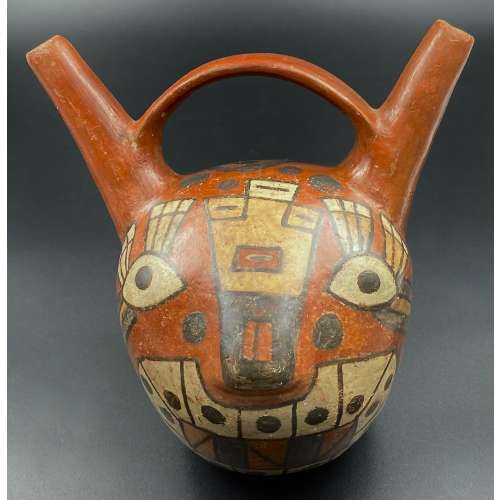 Pre-Columbian, Peru, Wari (Huari) culture, ca. 650 to 1000 CE.
Pre-Columbian, Peru, Wari (Huari) culture, ca. 650 to 1000 CE.A hand-built polychrome ceramic stirrup vessel depicting the head of a jaguar. Painted with a sienna-hued base, this spotted beast features an abstract visage of almond-shaped eyes opened wide with long feather-like lashes, a rectangular nose protruding from a nasal bridge decorated with a quadrilateral motif, and a large open mouth, showing both upper and lower teeth, which are also spotted, all painted in shades of cream, black, cream, grey, light grey, and beige. Highly burnished, the lustrous vessel exhibits two spouts, also functioning as ears of the jaguar, with a flat handle arching between them. This tool would have been a grave good intended to hold some kind of libation or offering and was likely made in a specialist workshop.
Colours: Sienna (base), black, cream, grey, light grey, beige (7 colours).
Dimension: Width (mouth-to-mouth): 15 cm; Height: 14.5 cm; Diameter of the body: 10.5 cm. Provenance: Hans Juergen Westermann collection, Germany. The Wari State was the first expansionistic power to develop in the Andean highlands. It was located in Vilcabamba, modern Espiritu Pampa (Plain of the Spirits), Echarate District of La Convención Province in the Cuzco Region of Peru. The Wari expanded around AD 650 and by the time of their collapse in AD 1000 they controlled much of the central Andes. -
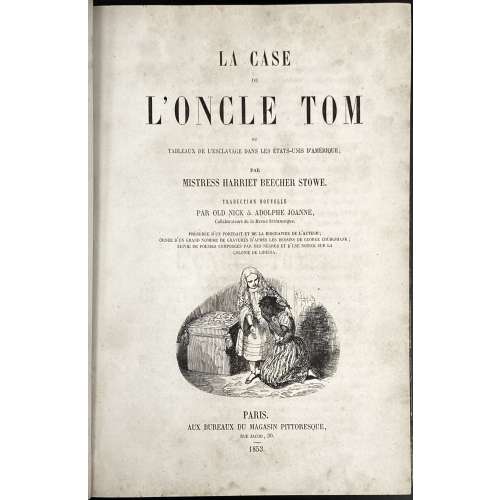 1st French edition (Paris, 1853) of Harriet Beecher Stowe's book Uncle Tom's Cabin; or, Life Among the Lowly, with 27 illustrations on wood by George Cruikshank (British, 1792 – 1878), translated into French by Paul-Émile Daurand-Forgues [pseudonym Old Nick] (French, 1813 – 1883) and Adolphe Joanne (French, 1813 – 1881). Title: LA CASE | DE | L'ONCLE TOM | OU | TABLE AUX DE L'ESCLAVAGE DANS LES ÉTATS-UNIS D'AMÉRIQUE ; | PAR MISTRESS HARRIET BEECHER STOWE. | TRADUCTION NOUVELLE | PAR OLD NICK & ADOLPHE JOANNE, | Collaboarteurs de la Revue britannique, | PRÉCÉDÉE D'UN PORTRAIT ET DE LA BIOGRAPHIE DE L'AUTEUR; | ORNÉE D'IU GRAND NOMBRE DE GRAVURES D'APRES LES DESSINS DE GEORGE CRUIKSHANK ; | SUIVIE DE POÉSIES COMPOSÉES PAR DES NÈGRES ET D'UNE NOTICE SUR LA | COLONIE DE LIBERIA. | [vignette] | PARIS. | AUX BUREAUX DU MAGASIN PITTORESQUE, | RUE JACOB, 30. | 1853. Pagination: ffl blank; [i-ii]: h.t. with stamped letters D. W. in the upper centre / imprim. to verso; [iii-iv] t.p. / blank; [v-vi] blank / frontispiece: portrait of Harriet Beecher Stowe, half-length to left, with hair in ringlets, and a shawl over shoulders, landscape behind, Henry Linton (British, 1815 – 1899) after Henry Anelay (British,1817 – 1883), wood-engraving with letterpress; [vij] Viij-xij; [1] 2-563 [564]; bfl blank; illustrations: 27 woodcuts by George Cruikshank. Collation: 8vo, π7 (1)–(35)8 363 Binding: Quarter brown calf, spine with raised bands, gilt-ruled compartments, title lettering, "D. W." in the bottom, marbled boards and endpapers. Dimensions: 24.1 x 16.4 cm. Catalogue raisonné: Albert M. Cohen (1924), №777, p. 221. "An edition was published in French with the woodcuts direct from the blocks, not, as in the English, merely from the stereotypes. The illustrations are far more impressive than those of Cassell's edition".
1st French edition (Paris, 1853) of Harriet Beecher Stowe's book Uncle Tom's Cabin; or, Life Among the Lowly, with 27 illustrations on wood by George Cruikshank (British, 1792 – 1878), translated into French by Paul-Émile Daurand-Forgues [pseudonym Old Nick] (French, 1813 – 1883) and Adolphe Joanne (French, 1813 – 1881). Title: LA CASE | DE | L'ONCLE TOM | OU | TABLE AUX DE L'ESCLAVAGE DANS LES ÉTATS-UNIS D'AMÉRIQUE ; | PAR MISTRESS HARRIET BEECHER STOWE. | TRADUCTION NOUVELLE | PAR OLD NICK & ADOLPHE JOANNE, | Collaboarteurs de la Revue britannique, | PRÉCÉDÉE D'UN PORTRAIT ET DE LA BIOGRAPHIE DE L'AUTEUR; | ORNÉE D'IU GRAND NOMBRE DE GRAVURES D'APRES LES DESSINS DE GEORGE CRUIKSHANK ; | SUIVIE DE POÉSIES COMPOSÉES PAR DES NÈGRES ET D'UNE NOTICE SUR LA | COLONIE DE LIBERIA. | [vignette] | PARIS. | AUX BUREAUX DU MAGASIN PITTORESQUE, | RUE JACOB, 30. | 1853. Pagination: ffl blank; [i-ii]: h.t. with stamped letters D. W. in the upper centre / imprim. to verso; [iii-iv] t.p. / blank; [v-vi] blank / frontispiece: portrait of Harriet Beecher Stowe, half-length to left, with hair in ringlets, and a shawl over shoulders, landscape behind, Henry Linton (British, 1815 – 1899) after Henry Anelay (British,1817 – 1883), wood-engraving with letterpress; [vij] Viij-xij; [1] 2-563 [564]; bfl blank; illustrations: 27 woodcuts by George Cruikshank. Collation: 8vo, π7 (1)–(35)8 363 Binding: Quarter brown calf, spine with raised bands, gilt-ruled compartments, title lettering, "D. W." in the bottom, marbled boards and endpapers. Dimensions: 24.1 x 16.4 cm. Catalogue raisonné: Albert M. Cohen (1924), №777, p. 221. "An edition was published in French with the woodcuts direct from the blocks, not, as in the English, merely from the stereotypes. The illustrations are far more impressive than those of Cassell's edition". -
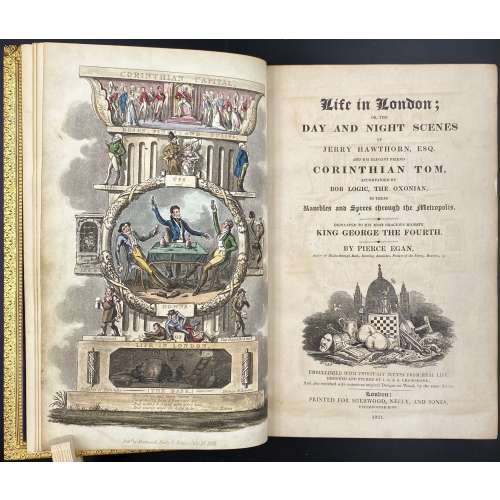
Title: Life in London ; | DAY AND NIGHT SCENES | OF | JERRY HAWTHORN, ESQ. | AND HIS ELEGANT FRIEND | CORINTHIAN TOM, | ACCOMPANIED BY | BOB LOGIC, THE OXONIAN, | IN THEIR |Rambles and Sprees through the Metropolis. | DEDICATED TO HIS MOST GRACIOUS MAJESTY | KING GEORGE THE FOURTH. | BY PIERCE EGAN, | Author of Walks through Bath, Sporting Anecdotes, Picture of the Fancy, Boxiana, &c. | [Vignette] | EMBELLISHED WITH THIRTY-SIX SCENES FROM REAL LIFE, | DESIGNED AND ETCHED BY I. R. & G. CRUIKSHANK ; | And also enriched with numerous original Designs on Wood, by the same Artists, | London: | PRINTED FOR SHERWOOD, NEELY, AND JONES, | PATERNOSTER-ROW. | 1821. ||
Edition: 1st edition, 1st issue: the first sheet of music is not numbered, absence of any footnote at page 9 (as per Cohn).
Pagination: 3 binder's flyleaves with a specimen of George Cruikshank's signature of Nov. 5th, 1860 to the first one; hand-coloured aquatint frontispiece facing the title page with blank recto, [iii-iv] – t.p. with vignette/ blank, [v] vi-viii – dedication, ix-xii – contents, [xiii]-xvi – list of illustrations; [1] 2-376; 35 hand-coloured aquatints, 3 folding leaves of music; bound without half-title [missing pp. i, ii], advertisements or 'to the subscribers' leaf.
Collation: 8vo; [A]7 B-Z8 Aa8-Bb4.
Binding: Full polished calf gilt by Rivière & Son, covers with triple gilt border, spine in 6 compartments, brown morocco lettering pieces to second and third, others richly gilt, raised bands, all edges gilt; neatly re-backed preserving spine.
Catalogue raisonné: Albert M. Cohn, 1924: № 262 p. 90; Abbey, J. R. (Life in England), 281; Tooley (Some English Books with Coloured Plates) 196; Prideaux (Aquatint Engraving) pp. 307, 310; Hardie (English coloured books) 197.
Description of Shapero Rare Books, London: There was a translation into French. At least six plays were based on Egan's characters, contributing to yet more sales. One of these was exported to America, launching the Tom and Jerry craze there. The version created by William Thomas Moncrieff was praised as The Beggar's Opera of its day. Moncrieff's production of Tom and Jerry, or Life in London ran continuously at the Adelphi Theatre for two seasons and it was the dramatist's work as much as the author's that did so much to popularise the book's trademark use of fashionable slang. In 1821 Egan announced the publication of a regular journal: Life in London, appearing monthly at a shilling a time. It was to be illustrated by George Cruikshank (1792 – 1878), and was dedicated to the King, George IV, who at one time had received Egan at court. The first edition of Life in London appeared on 15 July 1821. Egan's creation was an instant success. Pirate versions appeared, featuring such figures as 'Bob Tallyho', 'Dick Wildfire' and the like. Printmakers speedily knocked off cuts featuring the various 'stars' and the real-life public flocked to the 'sporting' addresses that Egan had his heroes frequent. -
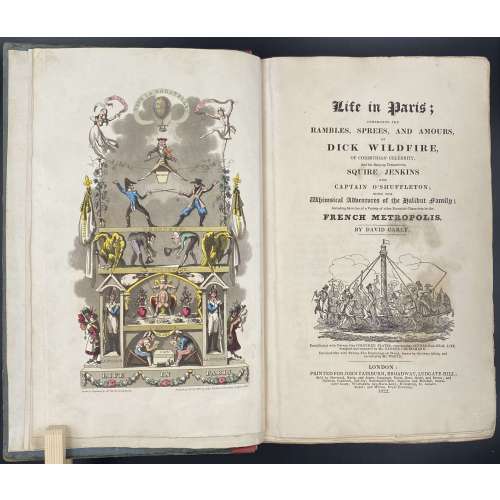
Title: Life in Paris ; | COMPRISING THE | RAMBLES, SPREES, AND AMOURS, | OF | DICK WILDFIRE, | OF CORINTHIAN CELEBRITY, | And his Bang-up Companions, SQUARE JENKINS | AND | CAPTAIN O’SHUFFLETON ; | WITH THE | Whimsical Adventures of the Halibut family ; | Including Sketches of a Variety of other Eccentric Characters in the | FRENCH METROPOLIS. | BY DAVID CAREY |[Vignette]| Embellished with Twenty-One COLOURED PLATES, representing SCENES from REAL LIFE, | designed and engraved by Mr. GEORGE CRUIKSHANK. | Enriched also with Twenty-Two Engravings on Wood, drawn by the same Artist, and | executed by Mr. WHITE. | LONDON : | PRINTED FOR JOHN FAIRBURN, BROADWAY, LUDGATE HILL; | Sold by Sherwood, Neely, and Jones ; Langman, Hurst, Rees, Orme, and Brown ; and | Baldwin, Craddoc, and Joy ; Paternoster-Row ; Simpkin and Marshall, Statio- | ners’ Court ; Whittakers Ave-Maria-Lane ; Humphrey, St. James’s | Street ; and Wilson, Royal Exchange. | 1822. ||
Edition: 1st edition in book form, 1st issue; large-paper copy bound from the parts in original blue paper boards, "most scarce" (Cohn).
Pagination: ffl, [i, ii] – h.t. ‘LIFE IN PARIS’ / ‘MARCHANT, Printer, Ingram-Court, London’, [2] – blank / Frontispiece (Ville la Bagatelle!!) hand-coloured, [iii, iv] – t.p. with vignette / blank, [v] vi-xxiv, [1] 2-489 [490 blank], [2] – 'TO THE BINDER' and 'Marchant, Printer, Ingram-Court, Fenchurch Street' "considered indispensable to a complete copy" (Cohn) / blank, bfl watermarked 1800; 21 hand-coloured aquatints and 22 wood-engraved text vignettes; cancelled leaves 143/4 and 335/6; pinholes from printing visible in most gatherings.
Collation: 4to; [a]-c4, B-Z4 Aa-Zz4 3A-3Q4 3R1 + [Ω]1
Binding: Original boards sometime re-backed with red paper, binder's end leaf watermarked 1800; red hard-grained morocco clamshell box.
Catalogue raisonné: Albert M. Cohn, 1924: № 109 p. 37/8; Abbey, J. R. (Life in England), 112; Tooley (Some English Books with Coloured Plates) 129; Hardie (English coloured books) 199.
Description of Shapero Rare Books, London: Of the copies that have come to auction since 1975 only one has been a large-paper copy in original boards. "The pictures are extremely spirited and true and are all the more wonderful in view of the fact that the artist’s continental experiences were limited to one day spent in Boulogne." (Hardie). In 1821, the journalist Pierce Egan published Life in London, an immediate success illustrated by the Cruikshank brothers, George and Robert. In order to capitalise on this success, another journalist, David Carey, decided to publish his own Life in Paris in monthly instalments (just like Life in London) and with a very similar frontispiece to the one that appears in Egan’s work; Life in Paris, however, was illustrated only by George Cruikshank. One of the earliest and most notable examples of the work of George Cruikshank, with fine, clean plates. -
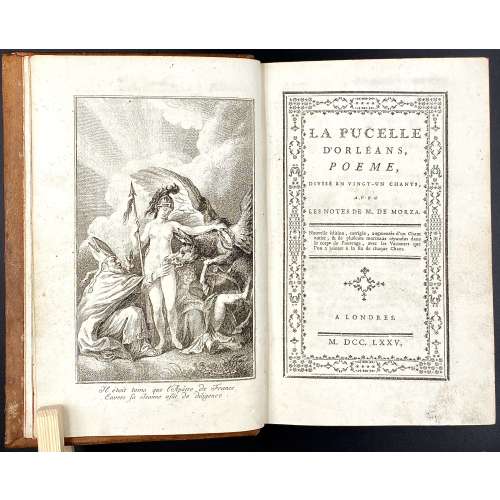 Half title: LA PUCELLE | D’ORLEANS.|| Title: LA PUCELLE | D’ORLEANS , | POEME , | DIVISÉ EN VINGT-UN CHANTS , AVEC | LES NOTES DE M. DE MORZA. | Nouvelle édition, corrigée, augmentée d'un Chant | entier, & de plusieurs morceaux répandus dans | le corps de l'ouvrage, avec les Variantes que | l'on a jointes à la fin de chaque Chant. | [ornament] | A LONDRES. |—| M. DCC. LXXV. || Pagination : [4] – two blank unnumbered fly leaves, [i,ii] – h.t. / double-ruled blank leaf, [2] – blank / frontispiece on verso, [iii, iv] – t.p. ruled and bordered / double-ruled blank leaf, [v]vi-viii – table, ix-xv – preface, [xvi] – double-ruled blank leaf, [1]2-447 [448] – double-ruled blank leaf, [2] – two blank unnumbered fly leaves; page 14 misnumbered 18; title within ornamental border; text within double-ruled borders; head- and tail-pieces; 22 leaves of plates (frontis. + one before each chant.) Collation: 8vo; a8 A-Z8 Aa-Ee8 Binding: 19.9 x 13.2 cm; full contemporary brown calf, blind ruled plates, spine with raised bands, gilt-ruled and tooled in compartments, red label with gilt lettering, all edges red; plate for chant 6, H4, H5 - separated from the block. De Morza is Voltaire (Cf. Quérard, v. 10, p. 306). Engravings unsigned; attributed to Desrais, Claude-Louis (French, 1746 – 1816). False imprint; possibly printed in Paris.
Half title: LA PUCELLE | D’ORLEANS.|| Title: LA PUCELLE | D’ORLEANS , | POEME , | DIVISÉ EN VINGT-UN CHANTS , AVEC | LES NOTES DE M. DE MORZA. | Nouvelle édition, corrigée, augmentée d'un Chant | entier, & de plusieurs morceaux répandus dans | le corps de l'ouvrage, avec les Variantes que | l'on a jointes à la fin de chaque Chant. | [ornament] | A LONDRES. |—| M. DCC. LXXV. || Pagination : [4] – two blank unnumbered fly leaves, [i,ii] – h.t. / double-ruled blank leaf, [2] – blank / frontispiece on verso, [iii, iv] – t.p. ruled and bordered / double-ruled blank leaf, [v]vi-viii – table, ix-xv – preface, [xvi] – double-ruled blank leaf, [1]2-447 [448] – double-ruled blank leaf, [2] – two blank unnumbered fly leaves; page 14 misnumbered 18; title within ornamental border; text within double-ruled borders; head- and tail-pieces; 22 leaves of plates (frontis. + one before each chant.) Collation: 8vo; a8 A-Z8 Aa-Ee8 Binding: 19.9 x 13.2 cm; full contemporary brown calf, blind ruled plates, spine with raised bands, gilt-ruled and tooled in compartments, red label with gilt lettering, all edges red; plate for chant 6, H4, H5 - separated from the block. De Morza is Voltaire (Cf. Quérard, v. 10, p. 306). Engravings unsigned; attributed to Desrais, Claude-Louis (French, 1746 – 1816). False imprint; possibly printed in Paris. -
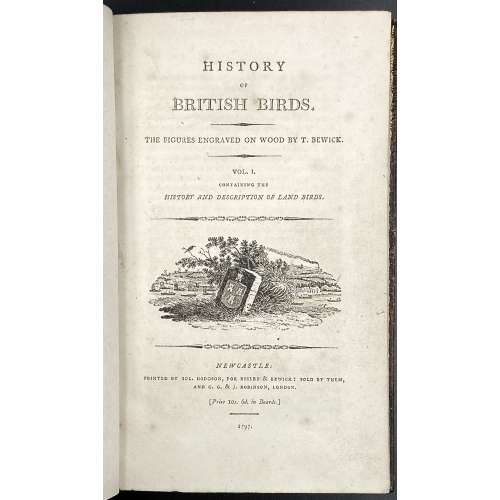 Volume 1: Title: HISTORY | OF | BRITISH BIRDS. | THE FIGURES ENGRAVED ON WOOD BY T. BEWICK. | VOL. I. | CONTAINING THE | HISTORY AND DESCRIPTION OF LAND BIRDS. | [Vignette] | NEWCASTLE: | PRINTED BY SOL. HODGSON, FOR BEILBY & BEWICK : SOLD BY THEM, | AND G. G. & J. ROBINSON, LONDON. | [Price 10s 6d. in Boards] | 1797|| Pagination: [2 blanks], [i, ii] – t.p. / blank, [iii] iv-xxx, [2] – f.t. / blank, [1] 2-335 [336 advert.] [2 blanks]; vignettes on t.p.'s; head- and tail-pieces; publisher's advertisement on final p. of v. 1. Collation: demi 8vo; a-b8, B-Y8; no sigs. A, p. 279 numbered correctly. Woodcuts: 140 descriptions of birds, 117 figures of birds, 91 vignettes, tail-pieces, etc. 1,000 copies printed. Variant B with a vignette at p. 22 printed vertically. Vignette at p. 285 without bars. Volume 2: Title: HISTORY | OF | BRITISH BIRDS. | THE FIGURES ENGRAVED ON WOOD BY T. BEWICK. | VOL. I. | CONTAINING THE | HISTORY AND DESCRIPTION OF WATER BIRDS. | [Vignette] | NEWCASTLE: | PRINTED BY EDWARD WALKER, FOR T. BEWICK : SOLD BY HIM, AND | LONGMAN AND REES, LONDON. | [Price 12s in Boards] | 1804|| Pagination: [2 blanks], [i, ii] – t.p. / blank; [iii] iv-xx, [1] 2-400, [2 blanks]. Collation: Demy 8vo in fours; a2 b-c4, A-3D4; E2, P2, Cc2 insigned. Woodcuts: 144 descriptions of birds, 101 figures of birds, 136 vignettes, tail-pieces, etc. Variant C: Vignette on p. 136 in 1st state, vignettes on pp. 269 and 359 in 2nd state. Binding: speckled full brown calf (restored), contemporary boards ruled in gilt, later spine with raised bands, gilt lettering and florets in compartments, marbled endpapers; 261 woodcut illustrations; printed on wove paper. In both volumes: armorial bookplate of "Clark, Knedlington, Yorks." with the motto "The time will come" on the front pastedown. Size: 21.5 x 14 cm, page: 20.6 x 12.6 cm, demi 8vo. Catalogue raisonné: Hugo (1866): № (99) 94 –120 (108) / pp. 40-58; Roscoe (1953): № 14 a-d, 17 a-d / pp. 46-52 and 65-76. See later edition in this collection: LIB-0860.2015.
Volume 1: Title: HISTORY | OF | BRITISH BIRDS. | THE FIGURES ENGRAVED ON WOOD BY T. BEWICK. | VOL. I. | CONTAINING THE | HISTORY AND DESCRIPTION OF LAND BIRDS. | [Vignette] | NEWCASTLE: | PRINTED BY SOL. HODGSON, FOR BEILBY & BEWICK : SOLD BY THEM, | AND G. G. & J. ROBINSON, LONDON. | [Price 10s 6d. in Boards] | 1797|| Pagination: [2 blanks], [i, ii] – t.p. / blank, [iii] iv-xxx, [2] – f.t. / blank, [1] 2-335 [336 advert.] [2 blanks]; vignettes on t.p.'s; head- and tail-pieces; publisher's advertisement on final p. of v. 1. Collation: demi 8vo; a-b8, B-Y8; no sigs. A, p. 279 numbered correctly. Woodcuts: 140 descriptions of birds, 117 figures of birds, 91 vignettes, tail-pieces, etc. 1,000 copies printed. Variant B with a vignette at p. 22 printed vertically. Vignette at p. 285 without bars. Volume 2: Title: HISTORY | OF | BRITISH BIRDS. | THE FIGURES ENGRAVED ON WOOD BY T. BEWICK. | VOL. I. | CONTAINING THE | HISTORY AND DESCRIPTION OF WATER BIRDS. | [Vignette] | NEWCASTLE: | PRINTED BY EDWARD WALKER, FOR T. BEWICK : SOLD BY HIM, AND | LONGMAN AND REES, LONDON. | [Price 12s in Boards] | 1804|| Pagination: [2 blanks], [i, ii] – t.p. / blank; [iii] iv-xx, [1] 2-400, [2 blanks]. Collation: Demy 8vo in fours; a2 b-c4, A-3D4; E2, P2, Cc2 insigned. Woodcuts: 144 descriptions of birds, 101 figures of birds, 136 vignettes, tail-pieces, etc. Variant C: Vignette on p. 136 in 1st state, vignettes on pp. 269 and 359 in 2nd state. Binding: speckled full brown calf (restored), contemporary boards ruled in gilt, later spine with raised bands, gilt lettering and florets in compartments, marbled endpapers; 261 woodcut illustrations; printed on wove paper. In both volumes: armorial bookplate of "Clark, Knedlington, Yorks." with the motto "The time will come" on the front pastedown. Size: 21.5 x 14 cm, page: 20.6 x 12.6 cm, demi 8vo. Catalogue raisonné: Hugo (1866): № (99) 94 –120 (108) / pp. 40-58; Roscoe (1953): № 14 a-d, 17 a-d / pp. 46-52 and 65-76. See later edition in this collection: LIB-0860.2015. -
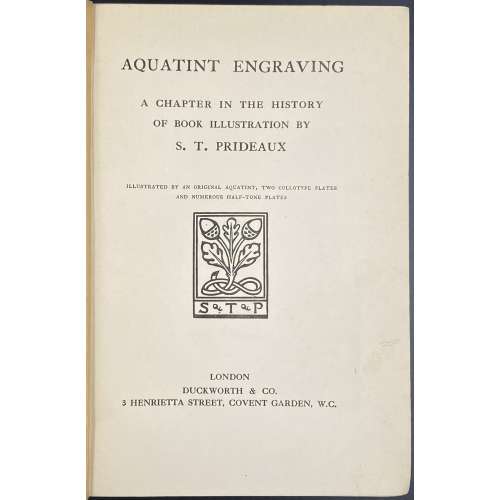 Half-title: AQUATINT ENGRAVING || Title: AQUATINT ENGRAVING | A CHAPTER IN THE HISTORY | OF BOOK ILLUSTRATION BY | S. T. PRIDEAUX | ILLUSTRATED BY AN ORIGINAL AQUATINT, TWO COLLOTYPE PLATES | AND NUMEROUS HALF-TONE PLATES | [Prideaux device] | LONDON | DUCKWORTH & CO. | 3 HENRIETTA STREET, COVENT GARDEN, W.C. || Pagination: ffl, [i, ii] – h.t. / blank, [2] – blank / frontis. w/guard, [iii, iv] – t.p. / coloph. "First Published, December 1909", [v, vi] – dedication "TO MY FATHER" / blank, vii-xv [xvi], [1] 2-434, bfl, + 24 pl. (incl. port). Collation: [a]6 b8 A-Z8 2A-2C8 2D4 Binding: Original navy cloth, gilt-ruled and lettered front board, gilt lettering to spine, a blind device to back board; upper margin gilt, free margin untrimmed. Author: Sarah Prideaux. "Engravers and the books they illustrated": p. 388-405. "Publications by Ackermann with aquatint plates": p. 374-378. "Biographical notices of engravers whose names appear on the plates": p. 358-371. "Books published before 1830 with aquatint plates": p. 325-357.
Half-title: AQUATINT ENGRAVING || Title: AQUATINT ENGRAVING | A CHAPTER IN THE HISTORY | OF BOOK ILLUSTRATION BY | S. T. PRIDEAUX | ILLUSTRATED BY AN ORIGINAL AQUATINT, TWO COLLOTYPE PLATES | AND NUMEROUS HALF-TONE PLATES | [Prideaux device] | LONDON | DUCKWORTH & CO. | 3 HENRIETTA STREET, COVENT GARDEN, W.C. || Pagination: ffl, [i, ii] – h.t. / blank, [2] – blank / frontis. w/guard, [iii, iv] – t.p. / coloph. "First Published, December 1909", [v, vi] – dedication "TO MY FATHER" / blank, vii-xv [xvi], [1] 2-434, bfl, + 24 pl. (incl. port). Collation: [a]6 b8 A-Z8 2A-2C8 2D4 Binding: Original navy cloth, gilt-ruled and lettered front board, gilt lettering to spine, a blind device to back board; upper margin gilt, free margin untrimmed. Author: Sarah Prideaux. "Engravers and the books they illustrated": p. 388-405. "Publications by Ackermann with aquatint plates": p. 374-378. "Biographical notices of engravers whose names appear on the plates": p. 358-371. "Books published before 1830 with aquatint plates": p. 325-357.


